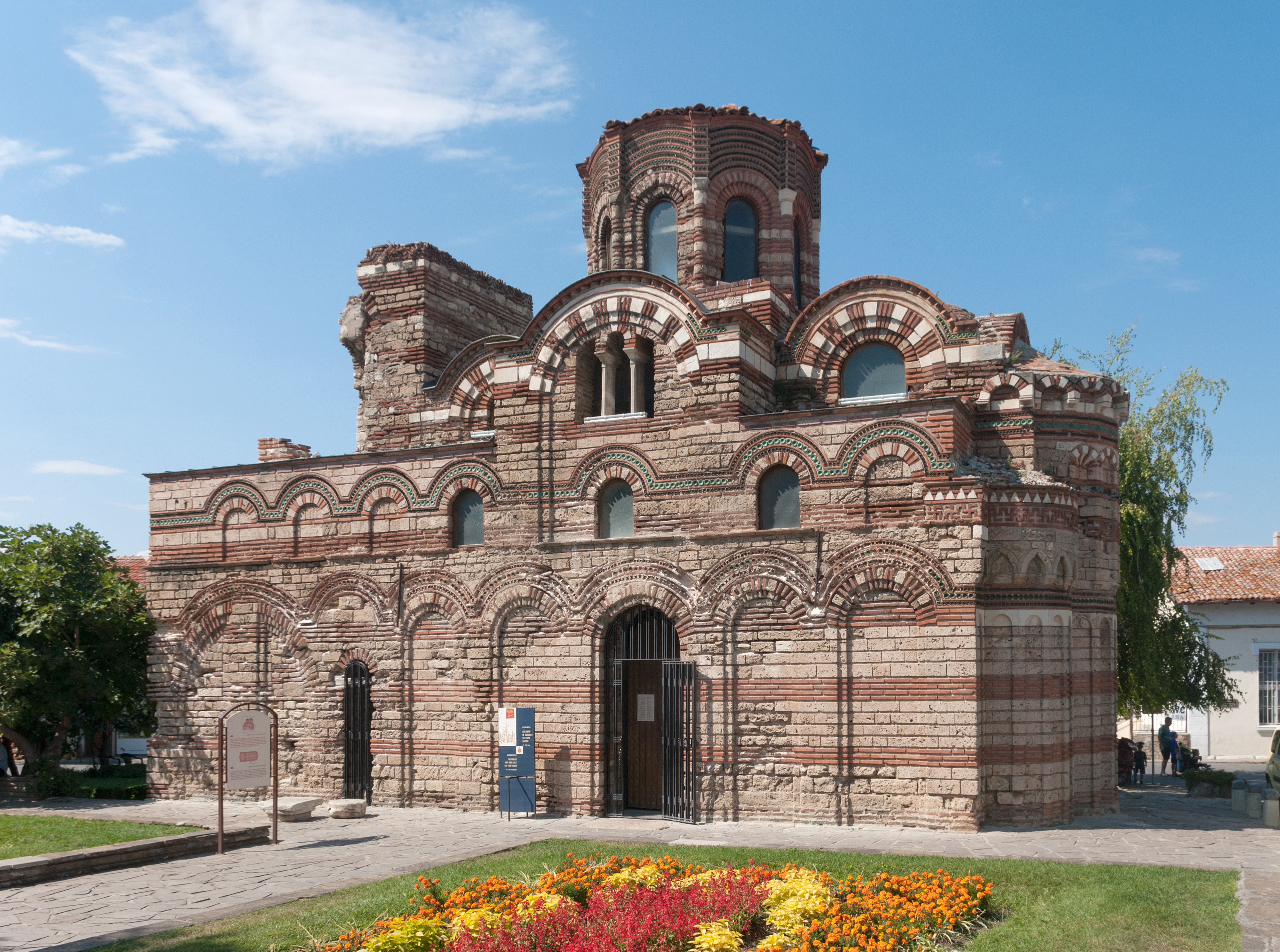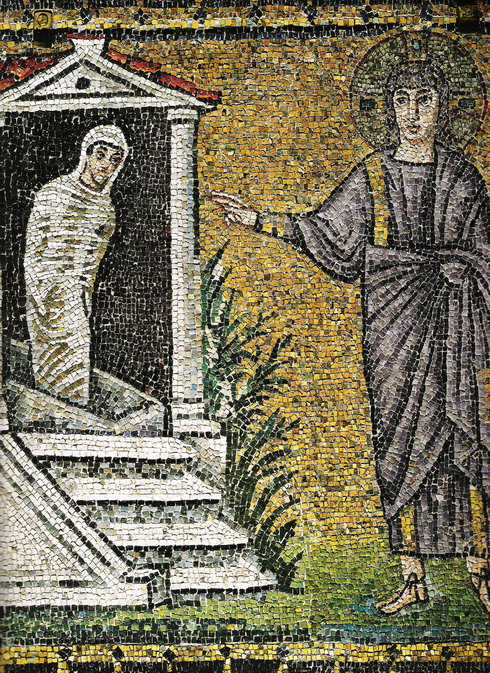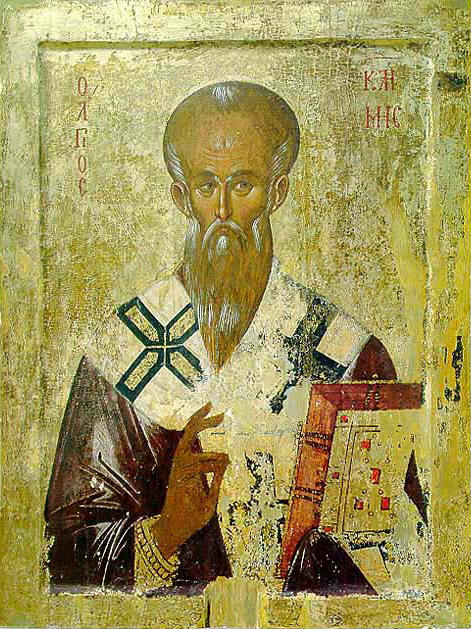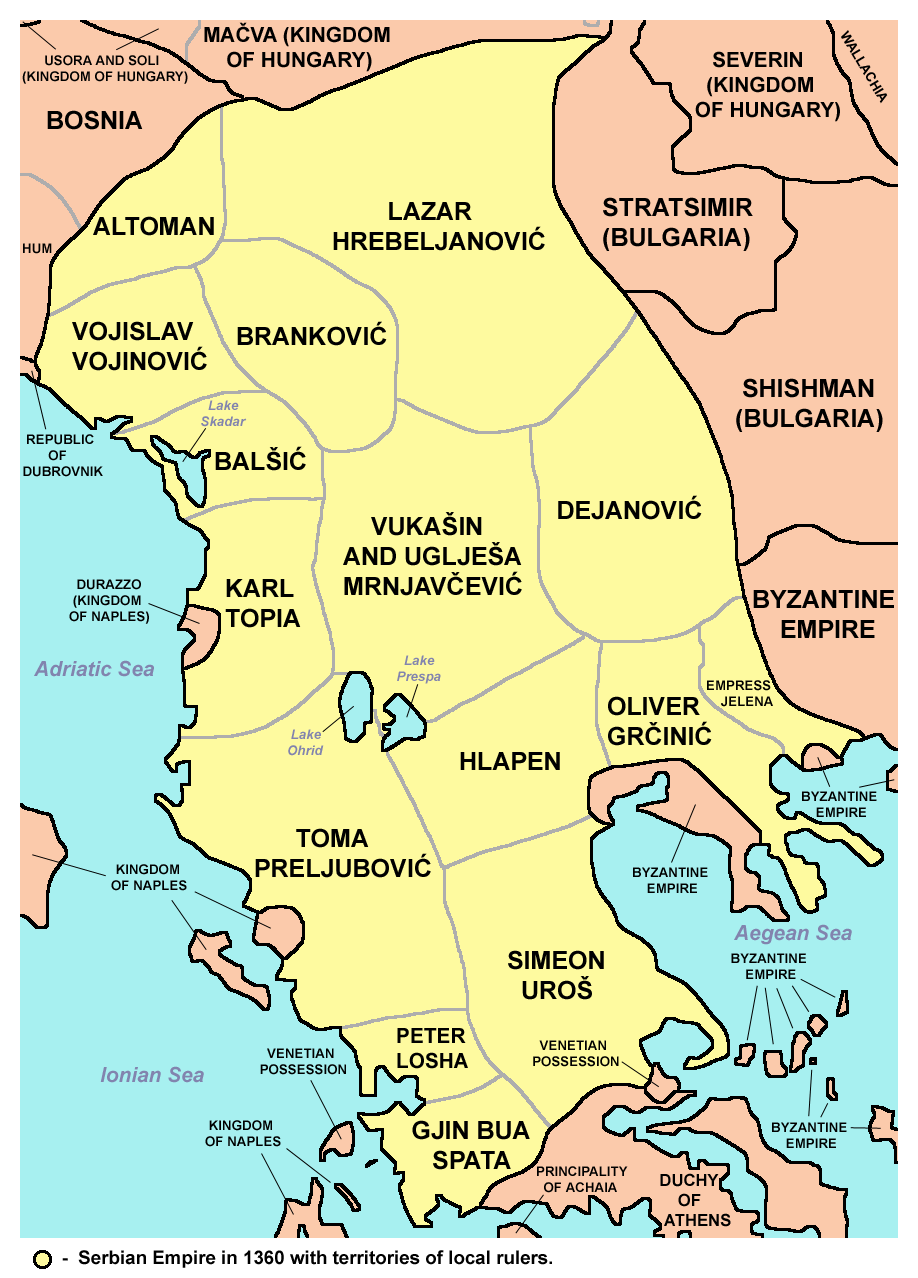|
Church Of St. Athanasius Of Mouzaki
St. Athanasius of Mouzaki () is a Greek Orthodox church located in Kastoria, Greece. It was built in 1383–84 by the brothers Teodor II Muzaka and Stoya Muzaka of the house of Muzaka, a noble Albanian family that controlled the city at the time, and dedicated to St. Athanasius It is considered one of the most important monuments of 14th century Kastoria and is the last church built in Kastoria before its annexation by the Ottoman Empire. Decorations The church is decorated with scenes of saints dressed in Byzantine clothing, a typical feature of Byzantine iconography. The frescoes are remarkable for depicting for the first time in Byzantine iconography, Jesus Christ and the Virgin Mary in imperial costume. The depiction of Virgin Mary as a queen is an atypical feature for the Byzantine iconography. Another unusual feature of the church is that, despite the fact that St. Alexander is traditionally not included among the ranks of military saints, the church of St Athanasius of ... [...More Info...] [...Related Items...] OR: [Wikipedia] [Google] [Baidu] |
Kastoria
Kastoria (, ''Kastoriá'' ) is a city in northern Greece in the modern regions of Greece, region of Western Macedonia. It is the capital of Kastoria (regional unit), Kastoria regional unit, in the Geographic regions of Greece, geographic region of Macedonia (Greece), Macedonia. It is situated on a promontory on the western shore of Lake Orestiada, in a valley surrounded by limestone mountains. The town is known for its many Byzantine Empire, Byzantine churches, Byzantine architecture, Byzantine and Ottoman architecture, Ottoman-era domestic architecture, its lake and its fur clothing industry. Name In the 6th century, the historian Procopius wrote the name Kastoria was used for the lake. The first reference to the town of Kastoria is by historian John Skylitzes writing about the late 10th century. The toponym Kastoria means "place of beavers" and is derived from ''kastori'' (καστόρι), the Greek word for European beaver, beaver and an animal whose local habitat was along ... [...More Info...] [...Related Items...] OR: [Wikipedia] [Google] [Baidu] |
Byzantine Style
Byzantine architecture is the architecture of the Byzantine Empire, or Eastern Roman Empire, usually dated from 330 AD, when Constantine the Great established a new Roman capital in Byzantium, which became Constantinople, until the fall of the Byzantine Empire in 1453. There was initially no hard line between the Byzantine and Roman Empires, and early Byzantine architecture is stylistically and structurally indistinguishable from late Roman architecture. The style continued to be based on arches, vaults and domes, often on a large scale. Wall mosaics with gold backgrounds became standard for the grandest buildings, with frescos a cheaper alternative. The richest interiors were finished with thin plates of marble or coloured and patterned stone. Some of the columns were also made of marble. Other widely used materials were bricks and stone. Mosaics made of stone or glass tesserae were also elements of interior architecture. Precious wood furniture, like beds, chairs, stools, ta ... [...More Info...] [...Related Items...] OR: [Wikipedia] [Google] [Baidu] |
Dormition Of The Mother Of God
The Dormition of the Mother of God is a Great Feast of the Eastern Orthodox, Oriental Orthodox, and Eastern Catholic Churches (except the East Syriac churches). It celebrates the "falling asleep" (death) of Mary the '' Theotokos'' ("Mother of God", literally translated as ''God-bearer''), and her being taken up into heaven. The Feast of the Dormition is observed on August 15, which for the churches using the Julian calendar corresponds to August 28 on the Gregorian calendar. The Armenian Apostolic Church celebrates the Dormition not on a fixed date, but on the Sunday nearest 15 August. In Western Churches the corresponding feast is known as the Assumption of Mary, with the exception of the Scottish Episcopal Church, which has traditionally celebrated the Falling Asleep of the Blessed Virgin Mary on August 15. Christian canonical scriptures do not record the death or Dormition of Mary. Hippolytus of Thebes, a 7th- or 8th-century author, writes in his partially preserved ch ... [...More Info...] [...Related Items...] OR: [Wikipedia] [Google] [Baidu] |
Lazarus Of Bethany
Lazarus of Bethany is a figure of the New Testament whose life is restored by Jesus four days after his death, as told in the Gospel of John. The resurrection is considered one of the miracles of Jesus. In the Eastern Orthodox Church, Lazarus is Veneration, venerated as Righteous Lazarus, the Four-Days Dead. The Eastern Orthodox and Catholic Church, Catholic traditions offer varying accounts of the later events of his life. In the context of the Book of Signs, seven signs in the Gospel of John, the raising of Lazarus at Bethany – today the town of Al-Eizariya in the West Bank, which translates to "the place of Lazarus" – is the climactic narrative: exemplifying the power of Jesus "over the last and most irresistible enemy of humanity: death. For this reason, it is given a prominent place in the gospel." The name ''Lazarus'' is frequently used in science and popular culture in reference to apparent restoration to life; for example, the scientific term Lazarus taxon denotes o ... [...More Info...] [...Related Items...] OR: [Wikipedia] [Google] [Baidu] |
Jerusalem
Jerusalem is a city in the Southern Levant, on a plateau in the Judaean Mountains between the Mediterranean Sea, Mediterranean and the Dead Sea. It is one of the List of oldest continuously inhabited cities, oldest cities in the world, and is considered Holy city, holy to the three major Abrahamic religions—Judaism, Christianity, and Islam. Both Israel and Palestine claim Jerusalem as their capital city; Israel maintains its primary governmental institutions there, while Palestine ultimately foresees it as its seat of power. Neither claim is widely Status of Jerusalem, recognized internationally. Throughout History of Jerusalem, its long history, Jerusalem has been destroyed at least twice, Siege of Jerusalem (other), besieged 23 times, captured and recaptured 44 times, and attacked 52 times. According to Eric H. Cline's tally in Jerusalem Besieged. The part of Jerusalem called the City of David (historic), City of David shows first signs of settlement in the 4th ... [...More Info...] [...Related Items...] OR: [Wikipedia] [Google] [Baidu] |
Christ
Jesus ( AD 30 or 33), also referred to as Jesus Christ, Jesus of Nazareth, and many other names and titles, was a 1st-century Jewish preacher and religious leader. He is the Jesus in Christianity, central figure of Christianity, the Major religious groups, world's largest religion. Most Christians consider Jesus to be the Incarnation (Christianity), incarnation of God the Son and awaited Messiah#Christianity, messiah, or Christ (title), Christ, a descendant from the Davidic line that is prophesied in the Old Testament. Virtually all modern scholars of classical antiquity, antiquity agree that Historicity of Jesus, Jesus existed historically. Accounts of Life of Jesus, Jesus's life are contained in the Gospels, especially the four canonical Gospels in the New Testament. Since the Age of Enlightenment, Enlightenment, Quest for the historical Jesus, academic research has yielded various views on the historical reliability of the Gospels and how closely they reflect the hi ... [...More Info...] [...Related Items...] OR: [Wikipedia] [Google] [Baidu] |
Theodore Stratelates
Theodore Stratelates (, ; ), also known as Theodore of Heraclea (; AD 281–319), was a martyr and warrior saint in the Eastern Orthodox, Catholic and Oriental Orthodox Churches. There is much confusion as to whether he and St. Theodore of Amasea were the same person, as the stories about their lives later diverged into two separate traditions. Life Of Greek origin, Theodore was born in the city of Euchaita in Asia Minor. He killed a giant serpent living on a precipice in the outskirts of Euchaita. The serpent had terrorised the countryside. Theodore armed himself with a sword and vanquished it. According to some of the legends, because of his bravery, Theodore was appointed military-commander (''stratelates'') in the city of Heraclea Pontica, during the time the emperor Licinius (307–324) began a fierce persecution of Christians. Theodore invited Licinius to Heraclea, having promised to offer a sacrifice to the pagan gods. He requested that all the gold and silver statu ... [...More Info...] [...Related Items...] OR: [Wikipedia] [Google] [Baidu] |
Theodore Tiron
: ''For another Saint Theodore, see: Theodore Stratelates or Saint Theodore (other)''. Saint Theodore (Άγιος Θεοδώρος), distinguished as Theodore of Amasea, Theodore the Recruit (Θεοδώρος ό Τήρων), and by other names, is a Christian saint and Great Martyr, particularly revered in the Eastern Orthodox Churches but also honored in Roman Catholicism and Oriental Orthodoxy. According to legend, he was a legionary in the Roman army who suffered martyrdom by immolation at Amasea in Galatian Pontus (modern Amasya, Turkey) during the Great Persecution under Diocletian in the early 4th century. Venerated by the late 4th century, he became a prominent warrior saint during the Middle Ages, attracted a great deal of additional legends including accounts of battle against dragons, and was often confused with (or was the original source of) the similar Theodore Stratelates of Heraclea. Names Theodore is the English form of the Latin masculine giv ... [...More Info...] [...Related Items...] OR: [Wikipedia] [Google] [Baidu] |
Clement Of Ohrid
Saint Clement (or Kliment) of Ohrid ( Bulgarian, Macedonian, , ''Kliment Ohridski''; , ''Klḗmēs tē̂s Akhrídas''; ; – 916) was one of the first medieval Bulgarian saints, scholar, writer, and apostle to the Slavs. He was one of the most prominent disciples of Cyril and Methodius and is often associated with the creation of the Glagolitic and Cyrillic scripts, especially their popularisation among Christianised Slavs. He was the founder of the Ohrid Literary School and is regarded as a patron of education and language by some Slavic people. He is considered to be the first bishop of the Bulgarian Orthodox Church, one of the Seven Apostles of Bulgarian Orthodox Church since the 10th century, and one of the premier saints of modern Bulgaria. The mission of Clement was the crucial factor which transformed the Slavs in then Kutmichevitsa (present-day Macedonia) into Bulgarians. Clement is also the patron saint of North Macedonia, the city of Ohrid and the Macedonian Orth ... [...More Info...] [...Related Items...] OR: [Wikipedia] [Google] [Baidu] |
Western Macedonia
Western Macedonia (, ) is one of the thirteen Regions of Greece, administrative regions of Greece, consisting of the western part of Macedonia (Greece), Macedonia. Located in north-western Greece, it is divided into the regional units of Greece, regional units of Florina (regional unit), Florina, Grevena (regional unit), Grevena, Kastoria (regional unit), Kastoria, and Kozani (regional unit), Kozani. With a population of approximately 255,000 people, as of 2021, the region had one of the highest unemployment rates in the European Union. Geography The region of Western Macedonia is situated in north-western Greece, bordering with the regions of Central Macedonia (east), Thessaly (south), Epirus (region), Epirus (west), and bounded to the north at the international borders of Greece with the Republic of North Macedonia (Bitola Municipality, Bitola, Resen Municipality, Resen and Novaci Municipality, Novaci municipalities) and Albania (Korçë County). Although it covers a total su ... [...More Info...] [...Related Items...] OR: [Wikipedia] [Google] [Baidu] |
Middle Ages
In the history of Europe, the Middle Ages or medieval period lasted approximately from the 5th to the late 15th centuries, similarly to the post-classical period of global history. It began with the fall of the Western Roman Empire and transitioned into the Renaissance and the Age of Discovery. The Middle Ages is the middle period of the three traditional divisions of Western history: classical antiquity, the medieval period, and the modern period. The medieval period is itself subdivided into the Early, High, and Late Middle Ages. Population decline, counterurbanisation, the collapse of centralised authority, invasions, and mass migrations of tribes, which had begun in late antiquity, continued into the Early Middle Ages. The large-scale movements of the Migration Period, including various Germanic peoples, formed new kingdoms in what remained of the Western Roman Empire. In the 7th century, North Africa and the Middle East—once part of the Byzantine Empire� ... [...More Info...] [...Related Items...] OR: [Wikipedia] [Google] [Baidu] |
Vukašin Of Serbia
Vukašin Mrnjavčević ( sr-Cyrl, Вукашин Мрњавчевић, ; c. 1320 – 26 September 1371) was King of Serbia as the co-ruler of Stefan Uroš V from 1365 to 1371. He was also a nobleman. Principal domains of Vukašin and his family were located in southern parts of medieval Serbia and northwestern parts of the modern region of Macedonia.King Vukasin and the Disastrous Battle of Maritsa M.A. Vladislav Boskovic, GRIN Verlag, 2009, He died in the in 1371 with his brother, Jovan Uglješa. In folk tradition, Vukašin is referred to as a usurper and, ... [...More Info...] [...Related Items...] OR: [Wikipedia] [Google] [Baidu] |







